公司治理对资本结构和企业价值关系的影响
外文翻译--公司治理对资本结构和企业价值关系的影响
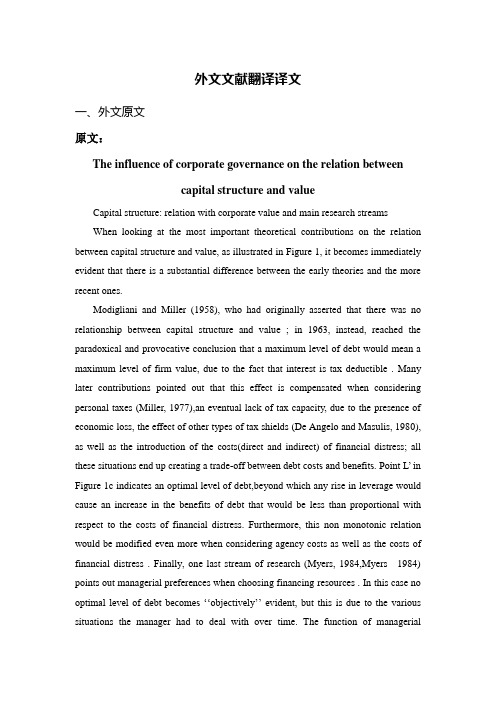
外文文献翻译译文一、外文原文原文:The influence of corporate governance on the relation betweencapital structure and valueCapital structure: relation with corporate value and main research streamsWhen looking at the most important theoretical contributions on the relation between capital structure and value, as illustrated in Figure 1, it becomes immediately evident that there is a substantial difference between the early theories and the more recent ones.Modigliani and Miller (1958), who had originally asserted that there was no relationship between capital structure and value ; in 1963, instead, reached the paradoxical and provocative conclusion that a maximum level of debt would mean a maximum level of firm value, due to the fact that interest is tax deductible . Many later contributions pointed out that this effect is compensated when considering personal taxes (Miller, 1977),an eventual lack of tax capacity, due to the presence of economic loss, the effect of other types of tax shields (De Angelo and Masulis, 1980), as well as the introduction of the costs(direct and indirect) of financial distress; all these situations end up creating a trade-off between debt costs and benefits. Point L’ in Figure 1c indicates an optimal level of debt,beyond which any rise in leverage would cause an increase in the benefits of debt that would be less than proportional with respect to the costs of financial distress. Furthermore, this non monotonic relation would be modified even more when considering agency costs as well as the costs of financial distress . Finally, one last stream of research (Myers, 1984,Myers 1984) points out managerial preferences when choosing financing resources . In this case no optimal level of debt becomes ‘‘objectively’’ evident,but this is due to the various situations the manager had to deal with over time. The function of managerialpreference has particular relevance due to information asymmetries, therefore the level of firm indebtedness will be determined by the tangent between the firm value function and the curve of manager indifference.Furthermore, it can be observed that debt increases in correspondence with the better the firm’s reputation is on the market (Chevalier, 1995). Research has shown similarities between firms that belong to the same sector (Titman and Wessels, 1988); in other words, capital structure tends to be industry-specific.The empirical comparison between the trade-off theory and the pecking order theory seems to be controversial. On one hand, empirical evidence shows moderate coherence with the trade-off theory, when revenue and agency problems are taken into consideration contextually; on the other hand, the negative relation between leverage and firm profit does not seem to support the trade-off theory, as it confirms a hierarchical order in financial decision making.It is, thus, clear that the topic of capital structure is anything but defined and that there are still many open problems regarding it.As many authors have noted (Rajan and Zingales, 1995) capital structure is a ‘‘hot’’ topic in finance. By analyzing international literature the main research priorities and new analytical approaches are related to:the important comparison between ‘‘rational’’ and ‘‘behavioural’’ finance (Barberis and Thaler, 2002);a lively comparison made between the pecking order theory and the trade-off theory(Shyam-Sunder and Myers, 1999);the attempt to apply these theories to small firms (Berger and Udell, 1998, Fluck, 2001);the role of corporate governance on the relation between capital structure and value(Heinrich, 2000, Bhagat and Jefferis, 2002, Brailsford et al., 2004, Mahrt-Smith, 2005).The behavioural approach, that considers the pecking order of financial resources in terms of ‘‘irrational’’ preferences, caused an immediate reactio n from Stewart Myers in 2000 and 2001 and jointly with Shyam-Sunder in 1999 (Myers, 2000; 2001; Shyam-Sunder and Myers,1999). Stewart Myers is the founder of the pecking order theory[7]. Problems of information asymmetry, together with transaction costs, would be able to offer a rational explanation to managerial behaviour when financial choicesare made following a hierarchical order (Fama and French, 2002). In other words, according to Myers and Fama, there should be a‘‘rational’’ explanation to the phenomenon observed by Stein, Baker, Wrugler, Barberis and Thaler.Moreover, studies on capital structure have also been done looking at small and medium size firms (Berger and Udell, 1998, Michaelas et al., 1999, Romano et al., 2000, Fluck, 2001),due to the relevant economic role of these firms (in Europe they are 95 percent of the total firms operating). Zingales (2000) as well has emphasized the fact that today ‘‘ . . . the attention shown towards large firms tends to partially obscure firms that do not have access to the financial markets . . . ’’. In one of the most interesting studies done on this topic, Berger and Udell (1998) asserted that firm financial behaviour depends on what phase of their life cycle they are in. In fact, there should be an optimal pro-tempore capital structure, related to the phase of the life cycle that the firm is in.Finally, the observations of Michael Jensen (1986), made throughout his many contributions on corporate governance, as well as those of Williamson (1988), have encouraged a line of research that, revitalized in the second part of the nineties, seems to be quite promising as a means to analyze how corporate governance directly or indirectly influences the relation between capital structure and value (Fluck, 1998, Zhang, 1998, Myers, 2000, De Jong, 2002,Berger and Patti, 2003, Brailsford et al., 2004, Mahrt-Smith, 2005). In synthesis, it is possible to affirm, as it follows, that a joined analysis of capital structure and corporate governance is necessary when describing and interpreting the firm’s ability to create value (Zingales, 2000, Heinrich, 2000, Bhagat and Jefferis, 2002). This type of consideration could help overcome the controversy found when studying the relation between capital structure and value, on both a theoretical and empirical level.Influence of corporate governance on the relation between capital structure and value.Capital structure can be analyzed by looking at the rights and attributes that characterize the firm’s assets and that influence, with d ifferent levels of intensity, governance activities. Equity and debt, therefore, must be considered as both financialinstruments and corporate governance instruments (Williamson, 1988): debt subordinates governance activities to stricter management, while equity allows for greater flexibility and decision making power. It can thus be inferred that when capital structure becomes an instrument of corporate governance, not only the mix between debt and equity and their well known consequences as far as taxes go must be taken into consideration. The way in which cash flow is allocated (cash flow right) and, even more importantly, how the right to make decisions and manage the firm (voting rights) is dealt with must also be examined. For example, venture capitalists are particularly sensitive to how capital structure and financing contracts are laid out, so that an optimal corporate governance can be guaranteed while incentives and checks for management behavior are well established (Zingales, 2000)[10].Coase (1991), in a sort of critique on his own work done in 1937, points out that it is important to pay more attention to the role of capital structure as an instrument that can mediate and moderate economical transactions within the firm and, consequently, between entrepreneurs and other stakeholders (corporate governance relations).As explicitly pointed out by Bhagat and Jefferis (2002), when they pay particular attention to the relations between cause and effect and to their interactions recently described on a theoretical level (Fluck, 1998, Zhang, 1998, Heinrich, 2000, Brailsford et al., 2004,Mahrt-Smith, 2005), a ‘‘research proposal’’ that future empirical studies should evaluate should be, how corporate governance can potentially have a relevant influence on the relation between capital structure and value, with an effect of mediation and/or moderation.The five relations identified in Figure 2 describe:the relation between capital structure and firm value (relation A) through a role of corporate governance ‘‘mediation’’ ; the relation between capital structure and firm value (relation A) through the role of capital governance ‘‘moderation’’ (relation D);the role of corporate governance as a determining factor in choices regarding capital structure (relation E).All five relations shown in Figure 2 are particularly interesting and show two threads of research that focus on the relations between:corporate governance andcapital structure, where the dimensions of the corporate governance determine firmfinancing choices, causing a possible relation of co-causation Whether management voluntarily chooses to use debt as a source of financing to reduce problems of information asymmetry and transaction, maximizing the efficiency of its firm governance decisions, or the increase in the debt level is forced by the stockholders as an instrument to discipline behavior and assure good corporate governance, capital structure is influenced by corporate governance (relation E) and vice versa (relation B).On one hand, a change in how debt and equity are dealt with influences firm governance activities by modifying the structure of incentives and managerial control. If, through the mix debt and equity, different categories of investors all converge within the firm, where they have different types of influence on governance decisions, then managers will tend to have preferences when determining how one of these categories will prevail when defining the firm’s capital structure. Even more importantly, through a specific design of debt contracts and equity it is possible to considerably increase firm governance efficiency.On the other hand, even corporate governance influences choices regarding capital structure (relation E). Myers (1984) and Myers and Majluf (1984) show how firmfinancing choices are made by management following an order of preference; in this case, if the manager chooses the financing resources it can be presumed that she is avoiding a reduction of her decision making power by accepting the discipline represented by debt.Internal resource financing allows management to prevent other subjects from intervening in their decision making processes. De Jong (2002) reveals how in the Netherlands managers try to avoid using debt so that their decision making power remains un checked. Zwiebel(1996) has observed that managers don’t voluntarily accept the ‘‘discipline’’ of debt; other governance mechanisms impose that debt is issued. Jensen (1986) noted that decisions to increase firm debt are voluntarily made by management when it intends to ‘‘reassure’’stakeholders that its governance decisions are ‘‘proper’’.In this light, firm financing decisions can be strictly deliberated bymanagers-entrepreneurs or else can be induced by specific situations that go beyond the will of the management.ConclusionThis paper define a theoretical approach that can contribute in clearing up the relation between capital structure, corporate governance and value, while they also promote a more precise design for empirical research. Capital structure represents one of many instruments that can preserve corporate governance efficiency and protect its ability to create value.Therefore, this thread of research affirms that if investment policies allow for value creation,financing policies, together with other governance instruments, can assure that investment policies are carried out efficiently while firm value is protected from opportunistic behavior.In other words, various authors (Borsch-Supan and Koke, 2000, Bhagat and Jefferis, 2002 and Berger and Patti, 2003) point out the necessity to analyze the relation between capital structure and value by always taking into consideration the interaction between corporate governance variables such as ownership concentration, management participation in the equity capital, the composition of the Board of Directors, etc.Furthermore, there is a problem in the way to operationalize these constructs, due to multidimensional nature of these. It is quite difficult to identify indicators that perfectly correspond to theoretical constructs; it means that proxy variables, or empirical measures of latent constructs, must be used (Corbetta, 1992).Moreover, it must be considered possible that there may be distortions in the signs and entities of the connections between variables due to endogeneity problems, or rather the presence of co-variation even when there is no cause, and reciprocal cause, where the distinction between the cause variable and the effect variable are lacking, and the two reciprocally influence each other.From an econometric point of view, therefore, it would seem to be important to further investigate the research proposal outlined above, by empirically examining the model proposed in Figure 2 using appropriate econometric techniques that can handle the complexity of the relations between the elements studied. Some proposals forstudy can be found in literature; the use of lagged variables is criticized by Borsch-Supan and Koke(2000) that affirm that it would be better to determine instrumental variables that influence only one of the two elements of study; Berger and Patti (2003), Borsch-Supan and Koke(2000) and Chen and Steiner (1999) promote the application of structural model equations to solve these problems, that is a method appropriate for examining the causal relations between latent, one-dimensional or multi-dimensional variables, measured with multiple indicators (Corbetta, 1992).In conclusion, this paper defines a theoretical model that contributes to clarifying the relations between capital structure, corporate governance and firm value, while promoting,as an aim for future research, a verification of the validity of this model through application of the analysis to a wide sample of firms and to single firms. To study the interaction between capital structure, corporate governance and value when analyzing a wide sample of firms,the researcher has to take into account the relations showed in Figure 2, look at problems of endogeneity and reciprocal causality, and make sure there is complementarity between all the three factors. Such an analysis deserves the application of refined econometric techniques. Moreover, these relations should be investigated in a cross-country analysis, to catch the role of country-specific factors.Source: Maurizio La Rocca,2007 “The influence of corporate governance on the relation between capital structure and value”. corporate gorernance,vol.7,no.3april,pp.312-325.二、翻译文章译文:公司治理对资本结构和企业价值关系的影响资本结构: 关系到公司价值及其主要研究趋向当查看关于描述资本结构与企业价值两者之间总体关系的最重要的理论文献时,会明显感觉到早期的理论与新近的理论有实质性的不同。
公司治理与资本结构的关系分析

公司治理与资本结构的关系分析摘要:在煤炭企业理论和实践的过程中,其中两个重要的问题就是公司治理和资本结构。
从理论和实践者两方面,对公司治理和资本结构的定义及其相关理论了解的基础上,通过公司治理和资本结构这两个理论体系的构建,立足于对煤炭企业公司治理和资本机构两者关系的系统性研究,在与国外典型公司治理的成功模式进行比较分析之后,对于改进和完善我国煤炭公司治理提出相关的意见和建议。
关键词:公司治理;资本结构;煤炭企业一、引言回顾我国公司治理的发展轨迹可以发现,我国的公司治理目前还是存在着内部治理机制存在失效、严重的代理内部人控制、股权结果不合理、对于精力人员和代理权竞争缺乏有效的约束机制、外部市场机制欠缺等一些问题。
摆在我国企业理论和实践界所必须去进行研究的课题就是对于公司治理和资本结构之间的矛盾。
二、公司治理和资本结构的定义及其相关理论1.公司治理的定义及其相关理论定义:公司治理也可以称之为企业管理,是一种体系当中由工商公司所进行控制和管理。
基本理论:金融模式论、市场短视论、利益相关者论分别作为公司治理的基本理论在企业公司治理的过程中,提供了重要的理论依据。
2.资本结构的定义及其相关理论定义:资本结构也就是长期性质的资本结构,依据这一客观实际,则必须列出营运资本进行管理的时候必须将短期债务包含其中。
基本理论:公司资本成本和资本机构这两者之间的关系问题是金融理论界所长期争论和关注的重点问题,从本质上就是对于各种资金来源所占据的比重大小,才能够使得有着最低的综合资本成本和最大的企业价值。
三、公司治理和资本结构的因素及现状分析---以煤炭行业为例目前煤炭企业的资产负债率都在50%左右的,这与其他类型的上市公司相比,这一比重显得比较低,而且与发达国家相比则显得更低。
其次,我国煤炭类的上市公司进行内源融资的比例低于20%,这与外源融资相比比例远远达不到其水平。
再次,债务类型结构上主要靠银行贷款中的低压担保模式。
论公司治理结构对企业资本结构影响

论公司治理结构对企业资本结构影响公司治理结构对企业资本结构具有重要影响,它涉及着公司内部关系的管理和决策机制的建立。
在市场经济条件下,公司治理结构已成为影响企业经营效率和资本结构的重要因素。
本文将从公司治理结构对企业资本结构的影响进行深入探讨。
一、公司治理结构对企业资本结构的影响1. 分权和控制公司治理结构中的分权和控制关系对企业资本结构具有显著的影响。
分权与控制的机制直接影响公司决策的效率和质量,从而影响企业的融资结构。
在一个公司中,如果在管理层和所有者之间存在着过多的代理问题和控制问题,就会导致公司的融资结构不稳定和不合理。
而如果分权和控制的机制健全,公司的融资结构就会更为合理和稳定。
2. 高管激励机制公司治理结构中的高管激励机制对企业的资本结构也有很大的影响。
高管的激励机制直接影响着公司的经营效率和财务状况,从而影响着公司的融资结构。
一些对高管薪酬的激励机制可能会导致高管为了短期业绩而采取不合理的融资结构,以获取高额的薪酬奖励。
而如果高管的激励机制更多地关注公司的长期利益,就会更有利于形成合理的融资结构。
二、影响公司治理结构对企业资本结构的因素1. 法律法规不同国家和地区的法律法规对公司治理结构和企业资本结构都有着不同的规定和要求。
一些国家和地区的法律法规对公司治理结构和股东权益保护非常重视,这就会促使公司建立起更为合理的治理结构,从而影响着公司的资本结构。
而一些国家和地区的法律法规对公司治理结构和股东权益保护较为疏漏,就可能导致公司治理结构和资本结构不合理。
2. 公司内部治理机制公司内部治理机制对公司的资本结构也有着重要的影响。
一些公司建立了较为完善的内部治理机制,如董事会、监事会、股东大会等,这些机制有利于促进公司内部的信息流通和决策效率,从而影响着公司的资本结构。
而一些公司的内部治理机制薄弱,内部信息流通不畅,就可能导致公司融资结构不稳定和不合理。
3. 资本市场资本市场对公司资本结构也有着重要的影响。
公司治理、现金持有量与公司价值的关系研究

公司治理、现金持有量与公司价值的关系研究内容摘要:本文利用2002年第一季度到2011年第三季度间A股上市公司的相关数据,考察公司治理对现金持有量的影响,进而分析公司现金持有量对公司价值的影响,结果发现代理理论对公司现金持有水平具有决定作用:公司治理较好的公司,往往持有更多的现金;较高的现金持有量会带来较高的市场价值,且这一效应在高成长性公司、高竞争度公司、高融资约束公司和民营控股公司中更加明显。
进一步引入公司治理后发现,无论公司特质,公司治理较好的公司,其现金持有价值始终较高。
关键词:公司治理现金持有量公司价值现金持有决策是一项重要的公司财务决策。
完美资本市场中,公司财务决策与公司价值无关(Modigliani和Miller,1958),但是现实中存在各种摩擦,交易成本、信息不对称等因素的存在使得公司或多或少都会持有一定数量的现金。
20世纪90年代末,西方企业出现大量持有现金与现金等价物的现象,引起了西方学者的广泛关注,对公司现金持有的影响因素展开了广泛的研究,取得了丰富的研究成果(Opler等,1999;Dittmar等,2003)。
现金是一种更能被自由处置与更易被侵占的资产,这就使得公司治理成为一个突出的影响因素,越来越多的研究从公司治理机制出发来研究公司现金持有行为。
现有的研究基本都达成了共识,认为公司治理影响公司现金持有量,但是对两者之间的关系还存在争议,根据自由现金流说,两者之间呈负相关,而根据现金花费说和股东权力说,两者之间呈正相关(Harford等,2008)。
还有的学者研究了现金持有的市场价值,目前也存在两种截然相反的观点,一种观点以Miller和Orr(1966)为代表,认为一定的现金持有有助于提升公司价值,另一种观点以Jensen(1986)为代表,认为资金的挥霍只能是价值破坏。
文献回顾早期有关公司现金的研究主要集中在公司如何维持最优现金水平,此后随着财务理论尤其是资本结构理论的发展和成熟,有关现金持有的理论也逐渐形成并完善。
资本结构与企业价值的关系

资本结构与企业价值的关系资本结构是指企业通过融资手段筹集的各种资本资源的构成和比重。
而企业价值是指企业在市场上所能创造的经济效益。
资本结构与企业价值之间存在着密切的关系,合理的资本结构能够有效地提升企业的价值。
本文将从企业的资本结构对企业价值的影响等方面来探讨资本结构与企业价值的关系。
一、资本结构的基本概念及类型资本结构是企业融资所形成的资本构成,主要由内部融资和外部融资两部分构成。
内部融资主要包括自有资本的利润留存和资产减值计提,外部融资主要包括债务融资和股权融资。
根据债务融资与股权融资的比重不同,资本结构可以分为债务型、股权型和混合型资本结构。
二、资本结构对企业价值的影响1. 资本结构对企业融资成本的影响不同的融资方式有不同的成本,债务融资相对于股权融资来说,具有较低的融资成本。
当企业的资本结构偏向债务融资时,可以降低融资成本,从而提升企业的盈利能力,进而提高企业的价值。
2. 资本结构对企业风险承受能力的影响债务融资相对于股权融资来说,存在较大的偿还压力和利息负担。
当企业的资本结构偏向债务融资时,如果遇到经营不善或者市场变化等风险因素,企业将可能面临偿债困难甚至破产的风险。
相比之下,股权融资能够分担企业的风险承受能力,降低企业的经营风险。
3. 资本结构对企业治理结构的影响资本结构的不同会对企业的治理结构产生直接的影响。
当企业的股权结构比较分散时,股东的权力较弱,企业治理结构较为松散,管理层的自由度相对较高,容易产生代理问题。
而当企业的股权结构较为集中时,股东的权力较强,能够更好地监督和约束管理层,提高企业的治理效率。
三、如何优化资本结构提升企业价值1. 合理配置资本企业应根据自身的经营状况和市场环境,合理配置内部和外部融资的比例。
可以通过增加自有资本的留存比例、引入风险投资等方式来改善资本结构,减少对债务融资的依赖。
2. 提高盈利能力企业应通过提高经营效益、扩大市场规模等方式,提高盈利能力,减少对外部融资的需求。
我国上市公司治理对资本结构影响的实证分析

[ 内容提要 ]在公 司资本结构理论的基础上 ,根据我 国证券 市场 的特 殊性 ,作 者 对我 国上 市公 司治理 结构和 资本结 构
之间的相 互关系提 出 了五个假设 ,并以我 国 沪、深两市 9 0家上市公 司作 为研 究样本 ,建 立 了相应 的模 型对相 应假 设进行 5
涉及 到新兴市场在 资本结构方 面的内容 ,缺乏这方 面 研究 的实证证据 。国内关 于股权结构与 资本结构 的研
究 主要集 中在股权结构形成 的原 因 、股权 结构与公 司
的 。按照这种理论假设 ,外 部大股东有监 督和影 响管
理人员 以保护他们投 资 的激励 (F ed& ag) i r n Ln 。考
于股权 的压力 ,使债权监督 在一定程度上 能弥补 这种
单纯依赖股权监督而导致 的此类 问题 。因此 ,股权 的
没有收集信息 和承担收集信息成本 的激励 以使 他们监
督 和控 制 管 理 者 行 为 ,于是 产 生 “ 便 车 ” 现 象 。 搭 中国上市 公司 的股权结构特点是 以国家股 和法 人股等 非流 通 股 为 主 体 ,流 动 股 在 股 权 结 构 中极 少 超 过 5 % ,在董事 会 或 监事 会 中几 乎 没有 个 人 股 东 的代 0 表 ,个人股东对 公司治理结构 的影响甚 微 。而且 ,中 国多数上市 公司召开股东大会 时 ,对与会 股东有 最小 持股数量 的限制 ,而 大 多数 流 通 股 持 股 主 体 是小 股 东 ,他们 的利益 不受保 护 。他们 既无 监督 管理 者的动
例增加 时 ,使得 控股股东能够 以更 小的成 本操 纵上市
公司 ,进 而降低 控股股东增加 负债的成 本。并 且 由于
流通股和非流通 股的人为市场 分割使得基 于企 业控制 权 的非对称信息 无法形成 良好 的传达途径 。 假设 五 :高 管薪酬 与公 司负债 比例无关 B re 等 ( 9 7 egr 19 )在研 究 C O薪酬 与公司债务水 E
资本结构与企业价值的关系研究
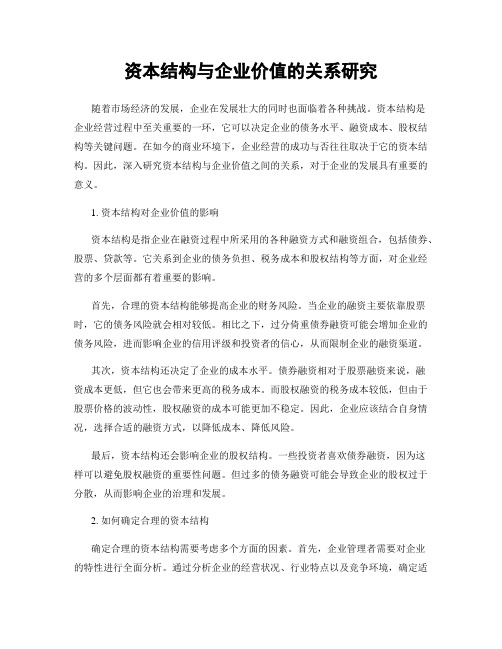
资本结构与企业价值的关系研究随着市场经济的发展,企业在发展壮大的同时也面临着各种挑战。
资本结构是企业经营过程中至关重要的一环,它可以决定企业的债务水平、融资成本、股权结构等关键问题。
在如今的商业环境下,企业经营的成功与否往往取决于它的资本结构。
因此,深入研究资本结构与企业价值之间的关系,对于企业的发展具有重要的意义。
1. 资本结构对企业价值的影响资本结构是指企业在融资过程中所采用的各种融资方式和融资组合,包括债券、股票、贷款等。
它关系到企业的债务负担、税务成本和股权结构等方面,对企业经营的多个层面都有着重要的影响。
首先,合理的资本结构能够提高企业的财务风险。
当企业的融资主要依靠股票时,它的债务风险就会相对较低。
相比之下,过分倚重债券融资可能会增加企业的债务风险,进而影响企业的信用评级和投资者的信心,从而限制企业的融资渠道。
其次,资本结构还决定了企业的成本水平。
债券融资相对于股票融资来说,融资成本更低,但它也会带来更高的税务成本。
而股权融资的税务成本较低,但由于股票价格的波动性,股权融资的成本可能更加不稳定。
因此,企业应该结合自身情况,选择合适的融资方式,以降低成本、降低风险。
最后,资本结构还会影响企业的股权结构。
一些投资者喜欢债券融资,因为这样可以避免股权融资的重要性问题。
但过多的债务融资可能会导致企业的股权过于分散,从而影响企业的治理和发展。
2. 如何确定合理的资本结构确定合理的资本结构需要考虑多个方面的因素。
首先,企业管理者需要对企业的特性进行全面分析。
通过分析企业的经营状况、行业特点以及竞争环境,确定适合企业的资本结构。
其次,企业需要结合自身的财务状况,以及未来的发展方向,进行资本结构的规划。
在确定资本结构时,企业还应该充分考虑投资者的意愿。
比如,如果董事会决定采用股票融资,但对股票市场不熟悉的投资者可能会选择其他投资机会。
因此,企业需要对投资者的心理状态和行为特点进行分析,以确定合适的资本结构。
公司资本结构、治理机制与企业价值的实证研究

股公司的业绩 和它们 的 经营 者 的报 酬 有微 弱 的 相关 性[ 引。
M la e n利用 C M U T T 业档案 中的 13 制造 业企业 作 w O Y SA 工 5家
为样本 , 对经理人员的报 酬结 构 和企 业 业绩进 行实 证研 究 ,
发现企业业绩和经理持有 股票期 权 的 比例 和其他 形式 的报
谢 建平
( 长沙市教育建 筑工 程有限公 司, 湖南 长沙 40 0 ) 1 3 0
摘
要 : 20 —20 沪、 以 0 4 06年 深两 市上 市公 司为研 究样本 , 对公 司资本 结构、 司治理 机制和 企业价值 公
的关 系进行研究。研究发现 , 负债 率和企业价值并 不是呈 简单 的线 形关 系, 资产 合理 的资本 结构有 利 于提
中图分 类号 :2 66 F7 .
文献标识 码 : A
文章编号 :08— 6 120 )4 03 3 10 4 8 (080 —02 —0
在西方 发达国家 , 内部 融资 、 债务 融资 和股权 融资 这样
一
经营决策 时更 多地 提高企业价值 , 因此 , 出以下假 没: 提
I: - 管理层持股 比例 与企业价 值正 相关 。 I 2 即管理层 持股
比例越高 , 企业价值越大 E.a a Fm 认为 , 独立董 事监 控 的原 因在 于他 们 是解 决管
理者与股东之 间代理 问题 的有效手段 , 董事会 需要在一 定程 度上独立于管 理层 , 能发 挥职 能L 。We be 才 8 J i ah发 现, s 如果
就 以上问题 进行 研究。
提 出 以下 假 设 :
H1债务 融资 与企 业价 值 正相 关 , : 即资 产负 债 率越 大 。
资本结构与公司价值的关系
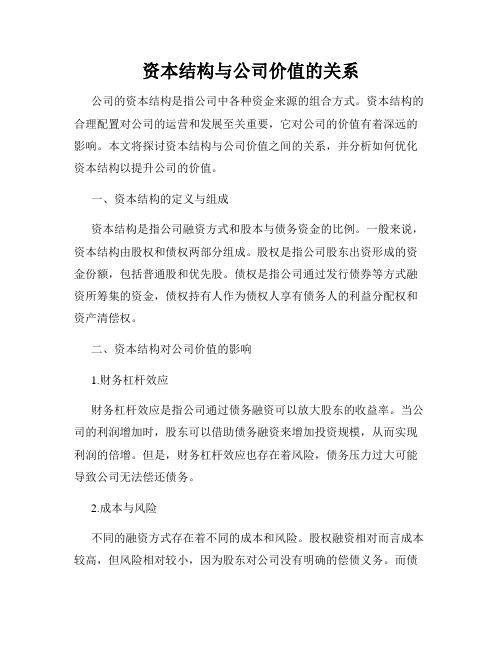
资本结构与公司价值的关系公司的资本结构是指公司中各种资金来源的组合方式。
资本结构的合理配置对公司的运营和发展至关重要,它对公司的价值有着深远的影响。
本文将探讨资本结构与公司价值之间的关系,并分析如何优化资本结构以提升公司的价值。
一、资本结构的定义与组成资本结构是指公司融资方式和股本与债务资金的比例。
一般来说,资本结构由股权和债权两部分组成。
股权是指公司股东出资形成的资金份额,包括普通股和优先股。
债权是指公司通过发行债券等方式融资所筹集的资金,债权持有人作为债权人享有债务人的利益分配权和资产清偿权。
二、资本结构对公司价值的影响1.财务杠杆效应财务杠杆效应是指公司通过债务融资可以放大股东的收益率。
当公司的利润增加时,股东可以借助债务融资来增加投资规模,从而实现利润的倍增。
但是,财务杠杆效应也存在着风险,债务压力过大可能导致公司无法偿还债务。
2.成本与风险不同的融资方式存在着不同的成本和风险。
股权融资相对而言成本较高,但风险相对较小,因为股东对公司没有明确的偿债义务。
而债权融资成本较低,但公司需要按时支付债务利息,并有明确的偿债义务。
因此,优化资本结构可以降低融资成本,减少公司的财务风险。
3.股东、债权人和管理层之间的利益博弈不同的股东结构和管理层的目标可能不一致,他们的利益博弈会对公司的决策产生影响。
股东希望获得较高的回报率,债权人希望确保本金和利息的安全,管理层则追求公司的长期价值增长。
优化资本结构需要平衡各方的利益,以实现公司的长期稳定发展。
三、优化资本结构的策略1.债务与股权的合理配置根据公司的经营情况和市场环境,合理配置债务和股权的比例。
对于盈利稳定、信用良好的企业来说,可以适当增加债务融资的比例;对于创新型、高风险的企业来说,宜增加股权融资的比例。
2.充分利用财务杠杆效应利用债务融资放大股东收益率的同时,要注意控制债务比例,避免财务风险的产生。
合理安排偿债计划,确保公司能够按时偿还债务。
3.增加内源性融资比例内源性融资包括自筹资金、保留盈利等方式,可以降低公司对外部融资的依赖程度。
公司治理结构对资本结构的影响分析
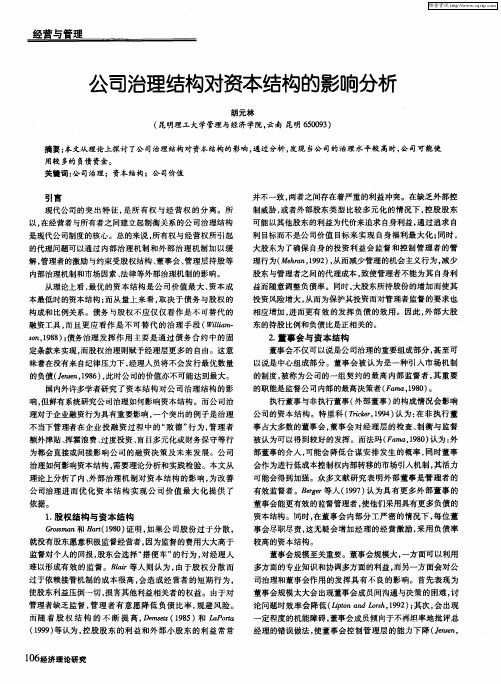
股东与管理者之 间的代理成பைடு நூலகம் , 致使管理者不能为其 自身利
益而随意调整负债率 。同时, 大股东所持股份的增加而使其
投资风险增大 , 从而为保护其投资而对管理者监督 的要求也 相应增加 , 进而更有 效的发挥负债的效用。因此 , 外部大股
东的持股比例和负债 比是正相关的。
S , 8 )债务治理发挥作用 主要是通过债务合约中的固 O 1 8; n9
部董事的介入, 可能会 降低合谋安排发生的概率 , 同时董事
会作为进行低成本控制权内部转移的市场引入机制 , 其活力 可能会得到加强。众多文献研究表 明外部董事是管理者的 有效监督者 。Bre等人 (97 认 为具有更多外部董事的 e r g 19 )
理论上分析了内、 外部治理机制对 资本结构的影 响, 为改善 公司治理进而优化 资本结构 实现 公 司价值 最大化提 供 了
就没有股东愿意积极监督经营者 , 因为监督的费用大大高于
监督对个人的回报 , 股东会选择“ 搭便车” 的行为 , 对经理人
董事会规模至关重要。董事会规模大 , 一方面可以利用 多方面的专业知识和协调多方面的利益 , 而另一方面会对公 司治理和董事会作用的发挥具有不 良的影响。首先表现 为 董事会规模太大会出现董事会成员间沟通与决策的困难 , 讨 论问题时效率会降低 (io n o h 19 )其次 , L t adLr , 2 ; pn s 9 会出现
维普资讯
经营与管理
公司治理结构对资本结构的影响分析
胡元林
( 昆明理工大学管理与经济学院, 云南 昆明 60 9 ) 50 3
摘要 : 本文从理论上探讨 了公司治理结构对资本结构的影响 , 通过分析 , 发现 当公 司的治理水平较 高时, 公司可能使
公司治理结构对公司发展的重要意义
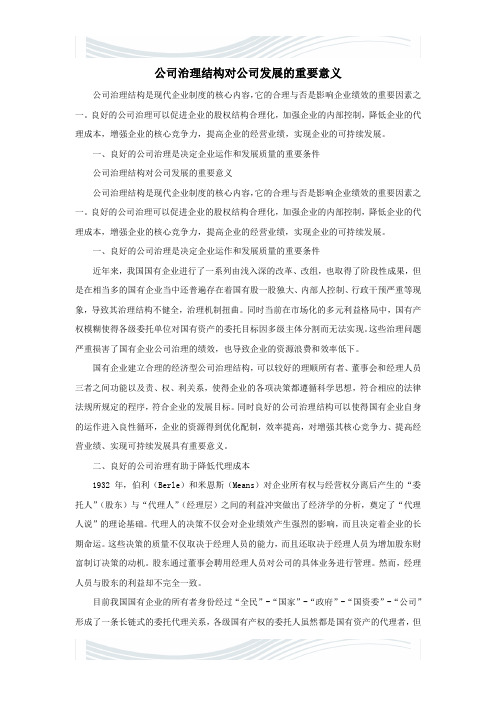
公司治理结构对公司发展的重要意义公司治理结构是现代企业制度的核心内容,它的合理与否是影响企业绩效的重要因素之一。
良好的公司治理可以促进企业的股权结构合理化,加强企业的内部控制,降低企业的代理成本,增强企业的核心竞争力,提高企业的经营业绩,实现企业的可持续发展。
一、良好的公司治理是决定企业运作和发展质量的重要条件公司治理结构对公司发展的重要意义公司治理结构是现代企业制度的核心内容,它的合理与否是影响企业绩效的重要因素之一。
良好的公司治理可以促进企业的股权结构合理化,加强企业的内部控制,降低企业的代理成本,增强企业的核心竞争力,提高企业的经营业绩,实现企业的可持续发展。
一、良好的公司治理是决定企业运作和发展质量的重要条件近年来,我国国有企业进行了一系列由浅入深的改革、改组,也取得了阶段性成果,但是在相当多的国有企业当中还普遍存在着国有股一股独大、内部人控制、行政干预严重等现象,导致其治理结构不健全,治理机制扭曲。
同时当前在市场化的多元利益格局中,国有产权模糊使得各级委托单位对国有资产的委托目标因多级主体分割而无法实现。
这些治理问题严重损害了国有企业公司治理的绩效,也导致企业的资源浪费和效率低下。
国有企业建立合理的经济型公司治理结构,可以较好的理顺所有者、董事会和经理人员三者之间功能以及责、权、利关系,使得企业的各项决策都遵循科学思想,符合相应的法律法规所规定的程序,符合企业的发展目标。
同时良好的公司治理结构可以使得国有企业自身的运作进入良性循环,企业的资源得到优化配制,效率提高,对增强其核心竞争力、提高经营业绩、实现可持续发展具有重要意义。
二、良好的公司治理有助于降低代理成本1932年,伯利(Berle)和米恩斯(Means)对企业所有权与经营权分离后产生的“委托人”(股东)与“代理人”(经理层)之间的利益冲突做出了经济学的分析,奠定了“代理人说”的理论基础。
代理人的决策不仅会对企业绩效产生强烈的影响,而且决定着企业的长期命运。
资本结构与公司治理

案例四:某公司的股利政策与资本结构的关联
总结词
股利政策与资本结构相互关联,共同影响公 司价值。
详细描述
该公司的股利政策和资本结构是相互关联的 。股利政策的制定需要考虑公司的现金流状 况、盈利能力和市场环境等因素。而资本结 构则直接影响公司的财务风险和经营稳定性 。因此,股利政策和资本结构需要相互协调 ,以实现公司价值的最大化。
02 公司治理
公司治理的定义
公司治理是指公司内部和外部的制度、机制和关系,旨在确保公司决策的科学性和 合法性,维护股东、债权人、员工、供应商和社会的利益。
公司治理涉及公司的组织结构、权力分配、决策程序、监督机制、激励机制以及企 业文化等方面。
公司治理的目标是提高公司的效率和长期绩效,同时平衡各方利益相关者的需求和 期望。
来避免负债违约。
管理层决策
资本结构还会影响管理层的决策 。例如,当公司负债较高时,管 理层在做决策时可能会更加谨慎
,以避免负债违约。
资本结构对投资者的影响
01 02
投资者利益
资本结构会影响投资者(包括大股东和中小股东)的利益。例如,当公 司主要依赖权益融资时,大股东可能会获得更多的收益,但中小股东的 权益可能会被稀释。
THANKS
感谢观看
资本结构与治理结构的互动关系
1 2
资本结构与治理结构的相互影响
资本结构和治理结构之间存在密切的互动关系, 二者相互影响、相互制约。
资本结构与治理结构的协同效应
通过协调资本结构和治理结构之间的关系,可以 实现协同效应,提高公司的整体价值。
3
ห้องสมุดไป่ตู้
资本结构与治理结构的适配性
适配性是指资本结构和治理结构之间的匹配程度 ,适配性越高,公司的绩效和价值就越高。
mm(modigliani-miller)定理
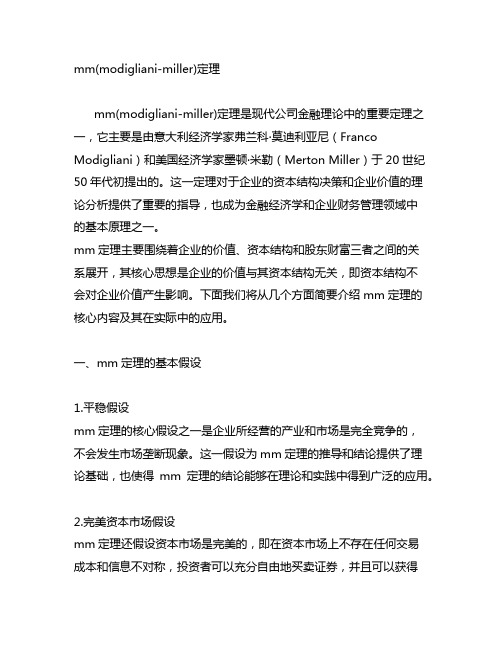
mm(modigliani-miller)定理mm(modigliani-miller)定理是现代公司金融理论中的重要定理之一,它主要是由意大利经济学家弗兰科·莫迪利亚尼(Franco Modigliani)和美国经济学家墨顿·米勒(Merton Miller)于20世纪50年代初提出的。
这一定理对于企业的资本结构决策和企业价值的理论分析提供了重要的指导,也成为金融经济学和企业财务管理领域中的基本原理之一。
mm定理主要围绕着企业的价值、资本结构和股东财富三者之间的关系展开,其核心思想是企业的价值与其资本结构无关,即资本结构不会对企业价值产生影响。
下面我们将从几个方面简要介绍mm定理的核心内容及其在实际中的应用。
一、mm定理的基本假设1.平稳假设mm定理的核心假设之一是企业所经营的产业和市场是完全竞争的,不会发生市场垄断现象。
这一假设为mm定理的推导和结论提供了理论基础,也使得mm定理的结论能够在理论和实践中得到广泛的应用。
2.完美资本市场假设mm定理还假设资本市场是完美的,即在资本市场上不存在任何交易成本和信息不对称,投资者可以充分自由地买卖证券,并且可以获得有关企业的一切信息。
这一假设为mm定理提供了理论前提条件,并使得mm定理的结论更加具有普遍适用性。
3.纳税假设mm定理还假设企业所面临的纳税情况是一致的,即不考虑个人所得税、公司所得税和其他税收差异对企业的影响。
这一假设在一定程度上简化了mm定理的推导和分析,使得mm定理的结论更加清晰和易于应用。
二、mm定理的核心内容1.企业价值与资本结构无关mm定理的核心内容之一是企业的价值与其资本结构无关,即企业价值不会因为改变其资本结构而产生变化。
这一结论为企业在进行资本结构决策时提供了重要的指导,也为投资者和管理者在进行投资决策时提供了理论依据。
2.资本成本与债务成本mm定理还指出了资本成本与债务成本之间的关系,即企业的资本成本等于其债务成本与权益成本的加权平均。
上市公司资本结构与公司治理关系研究

上市公司资本结构与公司治理的关系研究摘要:公司治理对公司发展是至关重要的,不同的治理结构对公司的资本结构会造成不同的影响。
为了更好地选择最优资本结构,构建最佳公司治理结构,实现企业价值最大化,必须清楚地认识到怎样的资本结构可以使得公司治理结构达到最佳。
关键词:公司治理;资本结构;企业价值最大化中图分类号:f832.5文献标识码:a文章编号:1001-828x(2011)08-0169-01资本结构是企业各种资本的构成及其比例关系。
即:资本结构既包括债务资本和股权资本之间的比例关系,还包括两种资本的内部结构和构成,即股权资本结构和债务资本结构;公司治理指为了提高公司价值、为了最大化创造和分享剩余收入,为了在公司全体利益相关者之间合理配置剩余索取权和控制权,而通过各种方式、渠道形成的互相制衡控制或影响企业重大决策的一系列的契约安排。
一、上市公司资本结构与治理结构的关系资本结构与公司治理结构是企业理论中的两个重要问题,二者之间存在着有机联系。
资本结构决策是企业融资决策的核心问题,它直接决定企业融资方式的选择及各种融资方式所占比例,从而影响股东、债权人、经理人等相关利益主体对企业控制的程度。
当引入信息不对称后,不同的资本结构设计影响了公司的治理成本,导致不同的公司业绩。
因此,可以通过资本结构的调整与变动,来控制经理人对公司利益的侵占,控制大股东对中小股东和债权人利益的侵占。
所以,有什么样的资本结构就有什么样的公司治理机制,资本结构的合理确定是公司有效治理的基础,资本结构、融资策略决定治理结构的模式。
在选择资本结构时,必须事先考虑某种特定的资本结构对企业权力分配的影响是怎么样的。
换言之,从决策机制上看,我们往往是根据设定所需要的权力分配结构,反过来考察这样的权力分配结构应建立在什么样的资本结构上。
因为不同的公司治理结构的安排会造成不同的资本结构选择。
如果股权适当分散,董事会与高管人员分离且各行其职,监事会真正起到监督约束的作用,那么公司就能选择恰当的融资策略,在不增加破产危机的前提下,很好地运用财务杠杆,使包括股权代理成本、债务代理成本在内的总代理成本最小,为公司创造更多的利润。
资本结构与公司治理
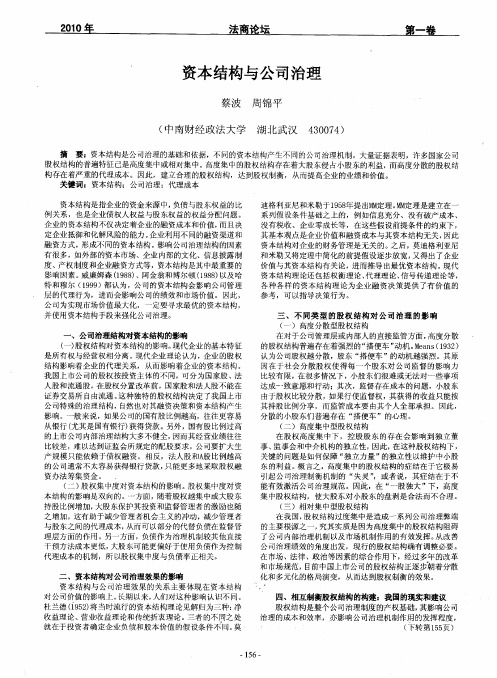
三 、不 同类 型 的股权 结构 对 公 司 治理 的影 响
( 一 )高度分散型股权结构 在对 于公司管理层或内部人 的直接监管方面 , 高度分散 的股权结构普遍存在着强烈的“ 搭便车 ” 动机 。 e n ( 9 2 M a s 13 ) 认为公司股权越分散,股东 “ 搭便车 ”的动机 越强烈 。其原 因在于社会 分散股 权使得每一个股东对 公司监 督的影响力 比较有限, 在很多情况下,小股 东们很难或无法对一些事项 达成一致意愿和行动;其次 ,监督存在成本的 问题 ,小股东 由于股权 比较分散 , 如果行使监督权,其获得的收益只能按 其持股比例分享 ,而监管成本要 由其个人全部承担。因此 , 分散的小股东们普遍存在 “ 搭便车 ”的心理 。 ( )高度集中型股权结构 二 在 股权高度集 中下 ,控 股股东的存在会影 响到 独立董 事、 监事会和 中介机构的独立性 , 因此 , 在这种股权 结构下 , 关键的问题是如何保障 “ 独立力量 ”的独立性 以维护 中小股 东 的 利益 。 言 之 , 度 集 中 的股 权 结 构 的 症 结在 于 它 极 易 概 高 引起 公 司 治理 制 衡 机 制 的 “ 灵 ” 或 者 说 ,其 症 结 在 于 不 失 , 能有效激活公司治理规范。因此 ,在 “ 一股独大 ”下,高度 集中股权结构 ,使大股东对小股东的盘 剥是合法而不合理 。 ( )相对集中型股权结构 三 在我国, 股权结构过度集中是造成 一系列公司治理弊端 的 主 要根 源 之 一 , 其 实 质 是 因 为高 度 集 中 的股 权 结 构 阻 碍 究 了公司内部治理机制以及市场机制作用 的有效发挥。 从改善 公司治理绩效的角度 出发 ,现行的股权 结构确有调整必要 。 在市场 、法律、政治等因素的综合作用下,经过多年的改革 和市场规范, 目前中国上市公 司的股权结构正逐步朝着分散 化和 多元化的格局演变 ,从而达到股权制衡 的效果。
企业融资、资本结构和公司治理的关系与应用

瘟罚
人。
则公司 的损 失会 更大1 由此造成 的公 员一般比外部 的投 资者具有更多的关于 的一致性与冲突性决定了企业和投资者 费 , 在资金融通和借贷方面的多种多样 的行 司价 值的损失称为剩余 损失 。当公司追 企业经营情况 的信息 。如果 用委 托—— 代理模型来 分析 ,在金融市场上的出资 为 ,形成 了金融市场上不同的融 资机制 加投资的价值增量正好被递增 的代理成 本所抵 消时 , 股票筹资达到最优规模。 为 者一般是委托人 ,而资金需求 者为代理 和 方式 。
维普资讯
口 王 晓 滨
贷款人 、 经理人 员和职工 融资是企业经营的基本问题。 按照 利益最大化 的.投资者是选择购买企业 相关者 即股东 、
金融资产类别 ,企业外部融资方式可以 的股份, 还是选择持有企业的债券 . 都需 之间的关系 ,以实现经济 目标的一整套 分为股权融资 、债权融资和衍生证券融 要在权衡收益 和风险之后作出决 策。企 制度 安排。在公司治理结构理论 的研究 资 , 中典型的融资方式是前两种 , 其 即为 业的经营是有 风险的 ,任何投资 的回报 中 , 公司 的所有者 印股东谥 看作是 “ 委 发行股票和借贷债务 。不同的融资方式 和收益都是不确定的。投资者的未来收 托 方 , 而公 司的经理 人员 是 “ 代理 一般认为 . 委托人和代理人均是以追 决 定 了企业 不 同的资 本结构 和股权 结 益依赖于企业 的经营结果 ,只是依赖程 方。 构 ,公司资本结构从形式上看是企业的 度和确定性的大小不同。持有股票 的投 求效用最大化为 目标 ,是 自利的经济行
上市公司资本结构对公司治理影响的研究论文
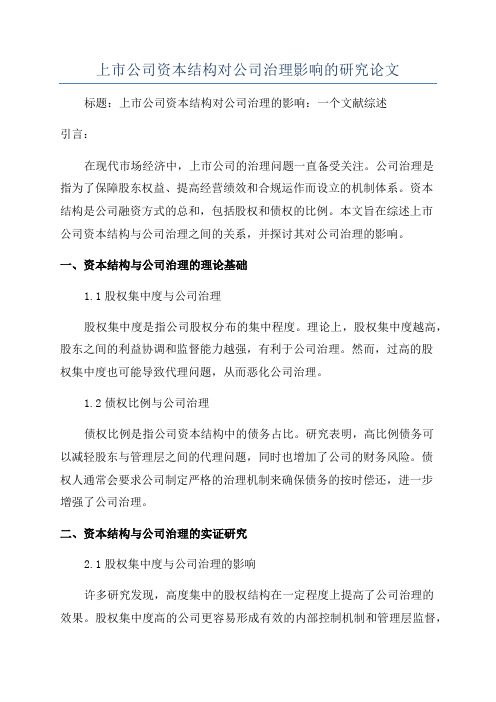
上市公司资本结构对公司治理影响的研究论文标题:上市公司资本结构对公司治理的影响:一个文献综述引言:在现代市场经济中,上市公司的治理问题一直备受关注。
公司治理是指为了保障股东权益、提高经营绩效和合规运作而设立的机制体系。
资本结构是公司融资方式的总和,包括股权和债权的比例。
本文旨在综述上市公司资本结构与公司治理之间的关系,并探讨其对公司治理的影响。
一、资本结构与公司治理的理论基础1.1股权集中度与公司治理股权集中度是指公司股权分布的集中程度。
理论上,股权集中度越高,股东之间的利益协调和监督能力越强,有利于公司治理。
然而,过高的股权集中度也可能导致代理问题,从而恶化公司治理。
1.2债权比例与公司治理债权比例是指公司资本结构中的债务占比。
研究表明,高比例债务可以减轻股东与管理层之间的代理问题,同时也增加了公司的财务风险。
债权人通常会要求公司制定严格的治理机制来确保债务的按时偿还,进一步增强了公司治理。
二、资本结构与公司治理的实证研究2.1股权集中度与公司治理的影响许多研究发现,高度集中的股权结构在一定程度上提高了公司治理的效果。
股权集中度高的公司更容易形成有效的内部控制机制和管理层监督,减少了代理问题的存在。
另一方面,高度集中的股权结构也通过限制小股东的权力增加了潜在的代理问题。
2.2债权比例与公司治理的影响资本结构中债务比例的变化也对公司治理产生了影响。
研究表明,债务占比高的公司更容易受到债权人的监督和约束,进而提高了公司治理。
然而,债务比例过高可能导致财务风险增加,甚至违约风险。
三、资本结构对公司治理的启示3.1平衡股权集中度与公司治理在确定股权分配时,公司应权衡股权集中度与公司治理之间的关系。
适度的股权集中度能够提高公司治理效果,但过高的集中度可能导致代理问题。
因此,公司可以考虑制定合理的股权激励机制,以平衡股东利益和公司治理的需求。
3.2控制债务比例合理化公司治理小额债务的使用可以增加公司的财务灵活性,但也应合理控制债务比例以避免财务风险。
资本结构与公司治理关系研究

-0.116 0.243 1.000
53.738
-7.974 0.000
1 可知我国上市公司股权集中度平均为 53.74%,处 于较高水平;根据方程的表 1 可知,我国上市公司 股权集中度、国有股比例分别与资产资本结构(资 产负债率)呈负相关和正相关关系;由表 1 可知回 归 F=31.793,P=0.000,这说明回归方程系数高度显 著.其中,股权集中度对资本结构影响系数为 -0.007, 且 P 很小,说明其对资本结构影响显著;国有股比 例对资本结构影响系数为 0.159,且 P=0.07,这说明 国有股比例对资本结构影响也比较显著,但相对股
按公司持股人种类化分,一般分为国家持股, 法人持股和普通流通股,不同持股人会对公司资本 结构产生影响.如果公司为国家持股控制,在这种 情况下公司产权比例一般较高,这是因为国家持主 要股分的公司一般情况下从银行等金融机构取得 贷款相对来说较为容易.相反,公司法人股和在流 通股比例越高相对于前者一般情况下不易从银行 取得借款,所以其采用发行股票方式融资行为较为 常见. 2.1.2 股权集中度对资本结构影响
1 资本结构与公司治理概述 公司治理是一种公司管理体制.在现代公司经
营模式中,所有权与管理权高度分离,在公司发生 融资和财产转移时,基于理性人假设,股东将采取 必要措施,最大化的保护其权益不受损害.通过公 司治理机制减小代理成本,这正是内部公司治理机 制的核心.公司治理机制对公司的作用又可分为注 重公司内部资本变化和经营决策的内部公司治理 和以债权人为保护其利益不受损害而对公司采取 监督管理的外部公司治理机制.
公司治理对资本结构的影响主要体现在由于 公司治理结构上的不同而产生的对公司资本结构 的影响.当代公司特征是公司所有权和经营权高度 分离,公司所有者与经营者、大股东与小股东之间 产生矛盾,出现代理问题.公司的股权结结构影响 公司的代理关系. 股权结构不同体现在两方面,一 方面是持股人不同而产生的股权结构不同,别一方 面是股权分散程度不同而产生不同的股权结构. 2.1.1 持股人种类差异化对资本结构影响
资本结构和企业价值的关系

资本结构和企业价值的关系资本结构是指企业在融资中选择不同的资金来源的比例和结构方式,包括股权和债权等。
企业价值是指企业创造的经济效益和市场地位等综合因素所体现的价值。
资本结构与企业价值之间存在着紧密的关系。
本文将从多个角度探讨资本结构对企业价值的影响。
一、资本结构对企业经营效益的影响资本结构的选择直接影响到企业的融资成本和财务风险。
在融资成本方面,债务融资的成本相对较低,而股权融资的成本较高。
因此,过度依赖债务融资可能导致企业支付过高的融资成本,降低经营效益;而过度依赖股权融资可能会稀释股东权益,影响企业的经营独立性。
在财务风险方面,债务融资的偿债压力较大,债务偿还存在较高的风险,一旦出现经营困难,可能导致企业破产。
因此,综合考虑融资成本和财务风险,企业应根据自身情况合理选择资本结构,以实现最佳的经营效益。
二、资本结构对企业投资能力的影响企业的投资能力决定了其未来的成长和发展潜力。
合理的资本结构可以影响企业的投资能力。
债务融资可以提高企业的杠杆比率,增加投资资金,促进企业的扩张和进一步发展;股权融资可以引入优秀的投资者和合作伙伴,提供更多的资源和支持,推动企业创新和拓展市场。
然而,过度依赖债务融资可能会导致企业还款压力过大,无法为新的投资项目提供足够的资金支持;过度依赖股权融资可能会限制企业的自主权,影响企业的长期发展。
因此,企业应根据自身的发展需要和市场环境,合理选择资本结构,以提升投资能力。
三、资本结构对企业市场竞争力的影响资本结构还对企业的市场竞争力产生影响。
债务融资可以提供相对稳定的融资支持,降低企业因融资不足而错失市场机会的风险;股权融资可以引入资金和资源,帮助企业进行技术创新和市场拓展。
合理的资本结构能够提高企业的市场竞争力,增强企业的抗风险能力和创新能力,提高企业的市场份额和品牌价值。
然而,过度倚重债务融资可能会造成企业财务负担过重,影响企业的市场地位;过度依赖股权融资可能会导致企业股权分散,降低企业的市场话语权。
资本结构与企业价值的关系分析

资本结构与企业价值的关系分析资本结构是企业资产及负债之间的比例关系,包括股权和债权比例。
而企业价值是指企业所创造的经济效益和市场认同程度。
资本结构与企业价值之间存在着紧密的关系,合理的资本结构有助于提高企业的价值。
1.影响资本结构的因素企业的资本结构受到多种因素的影响,包括盈利能力、经营风险、税收政策、外部融资环境等。
首先,盈利能力是影响资本结构的重要因素之一。
高盈利能力的企业更容易获得外部融资,从而形成相对较低的负债水平。
同时,经营风险也会对资本结构产生影响。
经营风险较高的行业更倾向于通过债务融资来分担风险,因此资本结构中负债比例较高。
税收政策也会对资本结构的选择产生影响,例如税收抵扣政策鼓励企业采用负债融资方式。
此外,外部融资环境直接影响企业融资成本和融资渠道,也会对资本结构产生影响。
2.资本结构对企业价值的影响合理的资本结构可以提高企业的价值。
首先,适当的债务水平可以降低企业的权益成本,增加股东的收益。
通过负债融资可以减少股东的投资金额,从而提高股东收益率。
其次,债务可以增加企业的财务杠杆效应。
当企业的资产回报率高于借款利息率时,利用债务可以放大企业的盈利能力,提高企业的价值。
然而,如果债务规模过大,将增加财务风险,可能面临偿债压力,对企业的价值产生负面影响。
因此,合理的资本结构需要根据企业盈利能力和经营风险来确定。
3.不同行业的资本结构差异不同行业的特点决定了资本结构的选择有所差异。
一般来说,稳定盈利能力的行业更适合采用股权融资,而高风险行业则更倾向于债务融资。
例如,制造业通常有稳定的现金流和资产,适合采用股权融资,而房地产行业因为高投资需求和波动风险较大,更适合债务融资。
然而,这并不是绝对规律,企业在选择资本结构时还需要考虑市场环境、行业竞争等因素。
4.资本结构优化的建议为了提高企业的价值,优化资本结构至关重要。
首先,企业应在盈利能力与风险承受能力之间找到平衡点。
过高的债务比例可能增加偿债风险,过低的债务比例又无法充分利用财务杠杆效应。
- 1、下载文档前请自行甄别文档内容的完整性,平台不提供额外的编辑、内容补充、找答案等附加服务。
- 2、"仅部分预览"的文档,不可在线预览部分如存在完整性等问题,可反馈申请退款(可完整预览的文档不适用该条件!)。
- 3、如文档侵犯您的权益,请联系客服反馈,我们会尽快为您处理(人工客服工作时间:9:00-18:30)。
外文文献翻译译文一、外文原文原文:The influence of corporate governance on the relation betweencapital structure and valueCapital structure: relation with corporate value and main research streamsWhen looking at the most important theoretical contributions on the relation between capital structure and value, as illustrated in Figure 1, it becomes immediately evident that there is a substantial difference between the early theories and the more recent ones.Modigliani and Miller (1958), who had originally asserted that there was no relationship between capital structure and value ; in 1963, instead, reached the paradoxical and provocative conclusion that a maximum level of debt would mean a maximum level of firm value, due to the fact that interest is tax deductible . Many later contributions pointed out that this effect is compensated when considering personal taxes (Miller, 1977),an eventual lack of tax capacity, due to the presence of economic loss, the effect of other types of tax shields (De Angelo and Masulis, 1980), as well as the introduction of the costs(direct and indirect) of financial distress; all these situations end up creating a trade-off between debt costs and benefits. Point L’ in Figure 1c indicates an optimal level of debt,beyond which any rise in leverage would cause an increase in the benefits of debt that would be less than proportional with respect to the costs of financial distress. Furthermore, this non monotonic relation would be modified even more when considering agency costs as well as the costs of financial distress . Finally, one last stream of research (Myers, 1984,Myers 1984) points out managerial preferences when choosing financing resources . In this case no optimal level of debt becomes ‘‘objectively’’ evident,but this is due to the various situations the manager had to deal with over time. The function of managerialpreference has particular relevance due to information asymmetries, therefore the level of firm indebtedness will be determined by the tangent between the firm value function and the curve of manager indifference.Furthermore, it can be observed that debt increases in correspondence with the better the firm’s reputation is on the market (Chevalier, 1995). Research has shown similarities between firms that belong to the same sector (Titman and Wessels, 1988); in other words, capital structure tends to be industry-specific.The empirical comparison between the trade-off theory and the pecking order theory seems to be controversial. On one hand, empirical evidence shows moderate coherence with the trade-off theory, when revenue and agency problems are taken into consideration contextually; on the other hand, the negative relation between leverage and firm profit does not seem to support the trade-off theory, as it confirms a hierarchical order in financial decision making.It is, thus, clear that the topic of capital structure is anything but defined and that there are still many open problems regarding it.As many authors have noted (Rajan and Zingales, 1995) capital structure is a ‘‘hot’’ topic in finance. By analyzing international literature the main research priorities and new analytical approaches are related to:the important comparison between ‘‘rational’’ and ‘‘behavioural’’ finance (Barberis and Thaler, 2002);a lively comparison made between the pecking order theory and the trade-off theory(Shyam-Sunder and Myers, 1999);the attempt to apply these theories to small firms (Berger and Udell, 1998, Fluck, 2001);the role of corporate governance on the relation between capital structure and value(Heinrich, 2000, Bhagat and Jefferis, 2002, Brailsford et al., 2004, Mahrt-Smith, 2005).The behavioural approach, that considers the pecking order of financial resources in terms of ‘‘irrational’’ preferences, caused an immediate reactio n from Stewart Myers in 2000 and 2001 and jointly with Shyam-Sunder in 1999 (Myers, 2000; 2001; Shyam-Sunder and Myers,1999). Stewart Myers is the founder of the pecking order theory[7]. Problems of information asymmetry, together with transaction costs, would be able to offer a rational explanation to managerial behaviour when financial choicesare made following a hierarchical order (Fama and French, 2002). In other words, according to Myers and Fama, there should be a‘‘rational’’ explanation to the phenomenon observed by Stein, Baker, Wrugler, Barberis and Thaler.Moreover, studies on capital structure have also been done looking at small and medium size firms (Berger and Udell, 1998, Michaelas et al., 1999, Romano et al., 2000, Fluck, 2001),due to the relevant economic role of these firms (in Europe they are 95 percent of the total firms operating). Zingales (2000) as well has emphasized the fact that today ‘‘ . . . the attention shown towards large firms tends to partially obscure firms that do not have access to the financial markets . . . ’’. In one of the most interesting studies done on this topic, Berger and Udell (1998) asserted that firm financial behaviour depends on what phase of their life cycle they are in. In fact, there should be an optimal pro-tempore capital structure, related to the phase of the life cycle that the firm is in.Finally, the observations of Michael Jensen (1986), made throughout his many contributions on corporate governance, as well as those of Williamson (1988), have encouraged a line of research that, revitalized in the second part of the nineties, seems to be quite promising as a means to analyze how corporate governance directly or indirectly influences the relation between capital structure and value (Fluck, 1998, Zhang, 1998, Myers, 2000, De Jong, 2002,Berger and Patti, 2003, Brailsford et al., 2004, Mahrt-Smith, 2005). In synthesis, it is possible to affirm, as it follows, that a joined analysis of capital structure and corporate governance is necessary when describing and interpreting the firm’s ability to create value (Zingales, 2000, Heinrich, 2000, Bhagat and Jefferis, 2002). This type of consideration could help overcome the controversy found when studying the relation between capital structure and value, on both a theoretical and empirical level.Influence of corporate governance on the relation between capital structure and value.Capital structure can be analyzed by looking at the rights and attributes that characterize the firm’s assets and that influence, with d ifferent levels of intensity, governance activities. Equity and debt, therefore, must be considered as both financialinstruments and corporate governance instruments (Williamson, 1988): debt subordinates governance activities to stricter management, while equity allows for greater flexibility and decision making power. It can thus be inferred that when capital structure becomes an instrument of corporate governance, not only the mix between debt and equity and their well known consequences as far as taxes go must be taken into consideration. The way in which cash flow is allocated (cash flow right) and, even more importantly, how the right to make decisions and manage the firm (voting rights) is dealt with must also be examined. For example, venture capitalists are particularly sensitive to how capital structure and financing contracts are laid out, so that an optimal corporate governance can be guaranteed while incentives and checks for management behavior are well established (Zingales, 2000)[10].Coase (1991), in a sort of critique on his own work done in 1937, points out that it is important to pay more attention to the role of capital structure as an instrument that can mediate and moderate economical transactions within the firm and, consequently, between entrepreneurs and other stakeholders (corporate governance relations).As explicitly pointed out by Bhagat and Jefferis (2002), when they pay particular attention to the relations between cause and effect and to their interactions recently described on a theoretical level (Fluck, 1998, Zhang, 1998, Heinrich, 2000, Brailsford et al., 2004,Mahrt-Smith, 2005), a ‘‘research proposal’’ that future empirical studies should evaluate should be, how corporate governance can potentially have a relevant influence on the relation between capital structure and value, with an effect of mediation and/or moderation.The five relations identified in Figure 2 describe:the relation between capital structure and firm value (relation A) through a role of corporate governance ‘‘mediation’’ ; the relation between capital structure and firm value (relation A) through the role of capital governance ‘‘moderation’’ (relation D);the role of corporate governance as a determining factor in choices regarding capital structure (relation E).All five relations shown in Figure 2 are particularly interesting and show two threads of research that focus on the relations between:corporate governance andcapital structure, where the dimensions of the corporate governance determine firmfinancing choices, causing a possible relation of co-causation Whether management voluntarily chooses to use debt as a source of financing to reduce problems of information asymmetry and transaction, maximizing the efficiency of its firm governance decisions, or the increase in the debt level is forced by the stockholders as an instrument to discipline behavior and assure good corporate governance, capital structure is influenced by corporate governance (relation E) and vice versa (relation B).On one hand, a change in how debt and equity are dealt with influences firm governance activities by modifying the structure of incentives and managerial control. If, through the mix debt and equity, different categories of investors all converge within the firm, where they have different types of influence on governance decisions, then managers will tend to have preferences when determining how one of these categories will prevail when defining the firm’s capital structure. Even more importantly, through a specific design of debt contracts and equity it is possible to considerably increase firm governance efficiency.On the other hand, even corporate governance influences choices regarding capital structure (relation E). Myers (1984) and Myers and Majluf (1984) show how firmfinancing choices are made by management following an order of preference; in this case, if the manager chooses the financing resources it can be presumed that she is avoiding a reduction of her decision making power by accepting the discipline represented by debt.Internal resource financing allows management to prevent other subjects from intervening in their decision making processes. De Jong (2002) reveals how in the Netherlands managers try to avoid using debt so that their decision making power remains un checked. Zwiebel(1996) has observed that managers don’t voluntarily accept the ‘‘discipline’’ of debt; other governance mechanisms impose that debt is issued. Jensen (1986) noted that decisions to increase firm debt are voluntarily made by management when it intends to ‘‘reassure’’stakeholders that its governance decisions are ‘‘proper’’.In this light, firm financing decisions can be strictly deliberated bymanagers-entrepreneurs or else can be induced by specific situations that go beyond the will of the management.ConclusionThis paper define a theoretical approach that can contribute in clearing up the relation between capital structure, corporate governance and value, while they also promote a more precise design for empirical research. Capital structure represents one of many instruments that can preserve corporate governance efficiency and protect its ability to create value.Therefore, this thread of research affirms that if investment policies allow for value creation,financing policies, together with other governance instruments, can assure that investment policies are carried out efficiently while firm value is protected from opportunistic behavior.In other words, various authors (Borsch-Supan and Koke, 2000, Bhagat and Jefferis, 2002 and Berger and Patti, 2003) point out the necessity to analyze the relation between capital structure and value by always taking into consideration the interaction between corporate governance variables such as ownership concentration, management participation in the equity capital, the composition of the Board of Directors, etc.Furthermore, there is a problem in the way to operationalize these constructs, due to multidimensional nature of these. It is quite difficult to identify indicators that perfectly correspond to theoretical constructs; it means that proxy variables, or empirical measures of latent constructs, must be used (Corbetta, 1992).Moreover, it must be considered possible that there may be distortions in the signs and entities of the connections between variables due to endogeneity problems, or rather the presence of co-variation even when there is no cause, and reciprocal cause, where the distinction between the cause variable and the effect variable are lacking, and the two reciprocally influence each other.From an econometric point of view, therefore, it would seem to be important to further investigate the research proposal outlined above, by empirically examining the model proposed in Figure 2 using appropriate econometric techniques that can handle the complexity of the relations between the elements studied. Some proposals forstudy can be found in literature; the use of lagged variables is criticized by Borsch-Supan and Koke(2000) that affirm that it would be better to determine instrumental variables that influence only one of the two elements of study; Berger and Patti (2003), Borsch-Supan and Koke(2000) and Chen and Steiner (1999) promote the application of structural model equations to solve these problems, that is a method appropriate for examining the causal relations between latent, one-dimensional or multi-dimensional variables, measured with multiple indicators (Corbetta, 1992).In conclusion, this paper defines a theoretical model that contributes to clarifying the relations between capital structure, corporate governance and firm value, while promoting,as an aim for future research, a verification of the validity of this model through application of the analysis to a wide sample of firms and to single firms. To study the interaction between capital structure, corporate governance and value when analyzing a wide sample of firms,the researcher has to take into account the relations showed in Figure 2, look at problems of endogeneity and reciprocal causality, and make sure there is complementarity between all the three factors. Such an analysis deserves the application of refined econometric techniques. Moreover, these relations should be investigated in a cross-country analysis, to catch the role of country-specific factors.Source: Maurizio La Rocca,2007 “The influence of corporate governance on the relation between capital structure and value”. corporate gorernance,vol.7,no.3april,pp.312-325.二、翻译文章译文:公司治理对资本结构和企业价值关系的影响资本结构: 关系到公司价值及其主要研究趋向当查看关于描述资本结构与企业价值两者之间总体关系的最重要的理论文献时,会明显感觉到早期的理论与新近的理论有实质性的不同。
